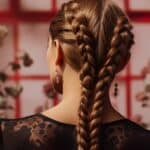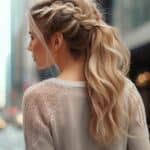Hair care is an essential aspect of personal grooming, as it plays a crucial role in maintaining the health and appearance of one’s tresses. The journey towards achieving healthy hair begins with understanding your hair type and selecting the appropriate hair care products and techniques. By making informed choices and adopting proper hair care routines, you can prevent damage, combat significant hair problems, and enhance the natural beauty of your locks.
Recognizing that each individual’s hair is unique, it’s essential to consider various factors such as hair texture, density, and porosity. These factors are critical in determining the best hair care regimen tailored to your needs. Additionally, understanding your scalp’s condition can profoundly impact hair health, enabling you to make suitable adjustments in your routine. Environmental influences, such as climate, pollution, and lifestyle choices, can further play a significant role in the overall well-being of your hair.
Key Takeaways
- Know your hair type and scalp condition to select suitable products and techniques for optimal hair health.
- Consider environmental factors like climate and pollution while determining your hair care routine.
- Personalize and regularly adapt your hair care regimen to address your needs and concerns.

Understanding Your Hair Type
Knowing your hair type is essential in creating an effective hair care routine. By understanding the unique characteristics of your hair, you can choose the right products and treatments to maintain its health and appearance. There are several factors to consider when identifying your hair type, including texture, density, and oiliness.
There are four main hair types: straight, wavy, curly, and coily. Straight hair (Type 1) tends to be oily due to the even distribution of natural oils from the scalp. People with straight hair should look for lightweight, oil-free products and wash their hair regularly to prevent buildup.
Wavy hair (Type 2) has a slight bend and texture, varying from fine to coarse. Depending on the thickness of the hair, wavy hair can be prone to frizz and might require specialized products to define and control the waves. Those with wavy hair should choose moisturizing, anti-frizz products and avoid heavy formulas that may weigh down their hair.
Distinct, spiraled curls characterize curly hair (Type 3). This hair type is often dry because natural oils have difficulty traveling down the hair shaft. Curly hair requires extra hydration, so individuals should focus on using deeply moisturizing, sulfate-free products. Minimizing hair breakage, avoiding excessive heat styling, and choosing gentle detangling techniques is crucial.
Coily hair (Type 4) consists of tightly coiled or kinky strands. Coily hair is the most fragile and prone to breakage due to its structure. Proper moisture and hydration are essential for this hair type, as well as gentle detangling and protective styling.
Another factor to consider in understanding your hair type is density, which refers to the number of hair strands on your scalp. Hair density can be classified as thin, medium, or thick, with each category requiring different levels of care. Fine or thin hair is delicate and may require more frequent washing and lightweight products to avoid being weighed down. Medium hair has a balance between thin and thick hair and should focus on using balanced, moisturizing products. Thick hair typically requires more intense moisturization and may benefit from heavier products or treatments.
In addition to texture and density, the oiliness of your hair is essential for choosing the proper care regimen. Oily hair can benefit from regular washing and oil-absorbing products, while dry hair needs deep hydration and more infrequent cleansing to avoid over-drying.
In conclusion, identifying your hair type—considering texture, density, and oiliness—is vital to developing a tailored and effective hair care routine. Choose products and treatments that complement your hair’s unique characteristics to promote overall health and beautiful results.
Proper Hair Washing Techniques
Proper hair washing is essential to maintaining your hair’s health and vitality. The proper techniques make all the difference in keeping your hair clean, moisturized, and looking great. Here are some vital things to keep in mind when washing your hair:
Firstly, it’s essential to choose the right shampoo and conditioner for your specific hair type. Look for products that cater to your hair’s specific needs, such as volumizing shampoos for thin hair or clarifying shampoos for greasy hair. If you have dry or curly hair, moisturizing shampoo and conditioner will help combat dryness and frizz. Additionally, you may consider a co-wash product to combine the cleansing and conditioning steps for increased convenience.
To begin the washing process, wet your hair thoroughly with lukewarm water. Hot water can strip the natural oils from the scalp and hair, causing it to become dry and brittle. Lukewarm water is gentler on both the hair and skin, helping to preserve the hair’s natural moisture.
After wetting the hair, distribute a small amount of shampoo (about the size of a dime or quarter, depending on the length and density of your hair) to the scalp area. Focus the cleansing action on the scalp rather than the entire hair length, as this is where sebum and dirt are produced. Massage your scalp gently with your fingertips, using circular motions to lift dirt and oil. Allow the shampoo to flow down the hair shaft while rinsing, cleaning the rest of the hair without causing dryness or frizz.
Next, apply conditioner to freshly washed hair, concentrating primarily on the lengths and ends. This helps to retain moisture and prevents the hair from becoming dry and tangled. Allow the conditioner to penetrate the hair shaft briefly before rinsing with lukewarm or cool water. Cold water helps close the hair cuticle, sealing in moisture and leaving your hair smooth and shiny.
Remember that over-washing your hair can strip the natural oils and lead to greasy hair as the scalp tries to compensate for the loss. Depending on your hair type, it might be best to wash your hair every two to three days—some people may even go longer between washes.
Incorporating these techniques into your regular shower routine will ensure your hair stays healthy, clean, and more manageable without causing unnecessary damage or dryness.
Hair Treatment and Care
Hair care routines play a crucial role in maintaining the health and appearance of your locks. Incorporating treatments into your hair care routine can target specific concerns, such as damaged hair, hair loss, and dryness. This section covers various treatments and care tips to help you achieve healthier hair.
Incorporating protein treatments into your routine can help strengthen and repair damaged hair. These treatments work by reinforcing the hair shaft with protein, making it more resistant to breakage. Protein treatments are especially beneficial for hair that has been chemically treated or exposed to heat styling.
Deep conditioners and hair masks are essential for restoring your locks’ much-needed hydration and nourishment. These products are formulated with nutrients and moisturizing agents that penetrate the hair shaft, leaving it soft, smooth, and healthy. Aim to use a deep conditioner or hair mask at least once a week, depending on your hair’s needs.
Dry shampoo offers a convenient solution for refreshing your hair between washes. It absorbs excess oil and residue, providing a cleaner appearance without water. This product is beneficial for individuals with oily hair or those who want to extend the life of their hairstyle.
Leaving-in conditioners provide continuous moisture and protection throughout the day. After washing, they can be applied to damp hair and help detangle, smooth, and hydrate your strands. This type of conditioner is ideal for those with dry or frizzy hair.
Hair loss can be a common concern for many individuals. Incorporating treatments specifically designed for hair loss, such as scalp serums or supplements, can help promote a healthier environment for hair growth. Speak with a professional or a dermatologist for personalized recommendations regarding hair loss treatments.
Natural oils like coconut, argan, and jojoba oil can work wonders for your hair. They provide hydration, seal in moisture, and help protect your strands from environmental damage. A few drops can be applied to the mid-lengths and ends, avoiding the roots to prevent an oily appearance.
Remember to trim your ends regularly to maintain your hair’s overall health. Doing so prevents split ends and breakage, promoting healthier growth in the long run. Schedule a trim with your hairstylist every six to eight weeks, depending on your hair type and desired length.
Styling Tips and Techniques
When it comes to hair care, it’s essential to utilize the right tools and techniques to create your desired style while also maintaining healthy hair. Whether you want to create bouncy curls, sleek straight locks, or a casual ponytail, follow these styling tips and techniques for successful results.
Before styling, it’s crucial to use a quality mousse or styling product, especially for heat styling. Applying mousse to damp hair will provide hold and volume, ensuring your chosen style lasts throughout the day.
When detangling hair, use a wide-tooth comb instead of a brush to minimize damage. This type of comb is ideal for gently separating hair strands without causing breakage, an essential step in preventing split ends.
For those frequently using heat styling tools, such as curling irons and straighteners, always consider using a heat protectant spray. Applying heat protectant before styling helps to shield your hair from heat damage, ultimately preserving its health and preventing dryness.
When it comes to blow-drying, opt for a high-quality dryer with multiple temperature settings. Using a lower heat setting can significantly reduce the potential damage from excessive heat. Also, consider using a concentrator nozzle attachment for more precise control and direction of airflow.
In the process of styling, various practical tips can help you achieve your desired look. For example, a paddle brush with a blow dryer can create smooth, straight locks, while a round brush can add volume and shape.
If you want to create curls with a curling iron, start by wrapping the hair around the iron, holding it in place for a few seconds before gently releasing it. This technique provides a more natural, soft curl rather than tight spirals.
A ponytail is an excellent option for individuals seeking a quick and simple updo. To create a sleek, polished look, dampen hair slightly and use a brush to smooth any flyaways or bumps before securing the ponytail with a hair tie.
In conclusion, by implementing these styling tips and techniques, you can confidently create various hair styles while maintaining your hair’s health and integrity.
Product Selection for Hair Care
When choosing hair care products, finding the right ones that cater to an individual’s specific hair type and needs is essential. Products can vary in terms of ingredients and benefits, so it’s crucial to select the right options for proper hair care.
Damage is a common concern when it comes to hair. To address this, look for products designed to repair and revitalize damaged hair, such as moisturizing shampoos, conditioners, and treatments containing proteins and natural oils. These ingredients can help strengthen the hair and restore its natural shine.
Establishing a consistent hair care routine is also essential in maintaining healthy hair. This routine should include washing and conditioning hair at an appropriate frequency to avoid over-drying or product buildup. Incorporating a moisturizing leave-in conditioner may help retain necessary moisture and reduce frizz for individuals with curly or textured hair.
Moisturizing products are essential in maintaining hair health. Dry hair can lead to breakage and damage, so it’s crucial to ensure that hair stays hydrated. Consider using products that contain natural oils, such as argan or coconut oil, as they can provide ample moisture and nourishment for the hair.
When it comes to brushes, selecting the proper tool for detangling and styling hair is key. Different hair types may require different brushes to avoid unnecessary damage or breakage. Wide-toothed combs are generally suitable for detangling curly or coarse hair, while paddle brushes with smooth bristles can be ideal for straight or fine hair.
Remember to pay attention to individual needs when selecting hair care products, as product efficacy can vary depending on hair type and condition. By carefully considering these factors and choosing the appropriate products, one can maintain healthy, strong, and beautiful hair.
Understanding and Caring for Your Scalp
The scalp is a crucial part of hair care as it is the foundation for healthy hair. Like other areas of the skin, the scalp can be prone to damage, irritation, and various conditions, making it essential to maintain its health. One can prevent hair loss and promote overall health by addressing the underlying issues, such as oil production and skin conditions like eczema or psoriasis.
Firstly, it is essential to establish a regular cleansing routine for the scalp. This includes using a gentle shampoo that focuses primarily on cleaning the scalp rather than the entire hair length. Concentrating on the scalp, it prevents flyaway hair or a dull appearance, leaving the hair looking healthy and vibrant. Following shampooing with a conditioner is vital unless using a 2-in-1 shampoo that also provides conditioning properties.
Secondly, it’s critical to manage oil production on the scalp. Excess oil can lead to a greasy appearance and weigh down the hair, while too little oil can cause dryness and irritation. Regular, gentle scalp cleansing will help maintain proper oil production, keeping the scalp’s natural moisture balance in check.
Additionally, addressing any skin conditions on the scalp, such as eczema or psoriasis, is essential for overall scalp health. Sufferers should consult a dermatologist for specific treatment recommendations tailored to their needs. Medicated shampoos or topical applications may be required to minimize symptoms and maintain a healthy scalp environment.
To further enhance scalp health, a scalp exfoliating scrub can be beneficial for removing excess product and dead skin cell buildup. Regular use of scrub will not only eliminate buildup but also promote better circulation to the hair follicles, potentially boosting hair growth and overall health.
Caring for the scalp is a vital aspect of overall hair care. By understanding its importance and maintaining a proper skincare routine that includes gentle cleansing, proper oil production, and addressing any underlying skin conditions, individuals can strive for a healthy scalp and enjoy its benefits for their hair.
Avoiding Common Hair and Scalp Problems
Caring for your hair and scalp is crucial in preventing common issues such as frizz, breakage, greasy roots, and even conditions like dandruff or acne. You can maintain healthy hair by adopting good hair care habits and being knowledgeable about the reasons behind these problems.
Firstly, be mindful of how often you wash your hair. Washing too frequently can strip away natural oils, leading to dry, frizzy hair, whereas washing too infrequently can cause greasy roots. Find a balance depending on your hair type and individual needs.
Choose the right hair care products for your specific hair type and needs. This includes using a gentle shampoo, a conditioner suitable for your hair texture, and any necessary treatments for concerns like dandruff or breakage. Avoid harsh chemicals that can damage hair and cause problems over time.
Be gentle when drying your hair to avoid causing breakage. Instead of rubbing your hair with a towel, wrap it up to absorb water, let it air dry or use low heat settings on a hairdryer.
Protect your hair from environmental damage. Sun exposure, pollution, and even swimming in chlorinated water can contribute to hair and scalp problems. Wear a hat or use a protective spray for sun protection and a swim cap or specially formulated swimmers’ shampoo and deep conditioner after swimming to minimize the effects of chlorinated water.
Regularly brush your hair to distribute natural oils from the roots to the ends, reducing greasy roots and preventing breakage. A gentle brush suitable for your hair type can also help minimize damage.
To maintain a healthy scalp, incorporate scalp care into your routine. This includes regular massages to stimulate blood circulation, proper application of scalp treatments, and shampoo promoting scalp health.
In summary, you can maintain a healthy scalp and hair by adopting good hair care habits and being attentive to the potential causes of hair loss and other issues. A confident, knowledgeable, and straightforward approach to these practices will help prevent typical hair and scalp problems.
The Influence of Your Environment on Hair Health
Various environmental factors can impact the health of your hair and scalp. Understanding these factors is essential in maintaining optimal hair health and preventing potential problems.
Exposure to sunlight is a common environmental stressor for hair. Ultraviolet (UV) rays can damage proteins in hair, making it more susceptible to breakage and loss. Additionally, scalp sunburn may cause irreversible damage to hair follicles, resulting in permanent hair loss. To mitigate the effects of sunlight, consider wearing protective headgear or using hair products with built-in UV protection.
Air pollution is another environmental factor that can negatively affect hair health. Pollutants can weaken hair fibers, often leading to hair thinning and breakage. Washing hair regularly and using products specifically formulated to counteract pollutants can help maintain hair health in polluted environments.
As humidity and dryness vary by location, they too, can impact hair health. Humid environments can exacerbate frizz and create the ideal conditions for fungal infections, such as scalp ringworm. On the other hand, arid environments may cause hair and scalp to dry out, making hair brittle and prone to breakage. A well-balanced hair care regimen, including deep conditioning and appropriate styling products, can help manage hair in various climate conditions.
Hygiene practices play a significant role in preventing particular hair and scalp issues. For example, head lice spread through direct hair-to-hair contact, while ringworm on the scalp can spread through contact with an infected person or item. To minimize the risk of infection, avoid sharing personal hair care items like combs or towels, and wash your hands regularly.
In the context of the coronavirus pandemic, maintaining proper hair and scalp hygiene is crucial. Although no evidence suggests that the virus spreads through hair, keeping your hair clean and healthy can further reduce the risk of transmission.
Preparing your hair to withstand environmental stressors requires a combination of protective measures, appropriate hair care products, and regular maintenance. By doing so, you can confidently face various environments while ensuring the health and appearance of your hair.
Personalizing Your Hair Care Routine
To maintain healthy and beautiful hair, creating a personalized hair care routine that suits your specific needs is essential. This involves considering your hair type, texture, and lifestyle choices.
Firstly, determine your hair type, which can be categorized into four main types: straight, wavy, curly, or coily. Your hair texture, on the other hand, can range from fine to medium to thick. Understanding these details will help you select the most appropriate products and techniques for your particular hair.
Next, evaluate your hair’s condition. Consider factors like dryness, oiliness, and overall damage caused by chemical treatments or heat-styling tools. This information is crucial as certain hair care products are specifically designed to address these conditions.
Moreover, take note of your scalp’s condition. A healthy scalp promotes hair growth and prevents issues like dandruff or itchiness. Choose shampoos and conditioners that cater to your scalp’s needs, whether soothing dryness or controlling excess oil.
In addition, consider the climate you live in, as it can impact your hair. For instance, humid environments might call for more robust anti-frizz products, while dryer climates may require more intensive hydration.
Finally, don’t forget about lifestyle factors. Your diet, exercise routine, and stress levels can all affect your hair’s health. A balanced diet with essential nutrients helps promote hair growth, while physical activity aids circulation and stress management. Regularly practicing stress reduction techniques like mindfulness or meditation can contribute to healthier hair.
By carefully examining your hair’s unique characteristics and lifestyle, you can create a customized hair care routine that caters to your needs. This tailored approach will help ensure your hair stays healthy, strong, and beautiful.
Frequently Asked Questions
What are the essential steps in a daily hair care routine?
A daily hair care routine typically involves regular shampooing, conditioning, and brushing. Washing your hair with a mild shampoo can help remove dirt, oil, and residue, maintaining a healthy scalp. Conditioning is essential, too, as it moisturizes the hair and prevents dryness. Gently brushing your hair can help to distribute the natural oils on the scalp and remove any tangles.
How can I repair damaged hair at home?
To repair damaged hair at home, use deeply nourishing products like hair masks, deep conditioners, and oils. You can also minimize heat styling and chemical treatments. Regularly trimming split ends and practicing gentle detangling techniques can contribute to healthier hair over time.
What are the best hair care products for men and women?
The best hair care products for men and women depend on individual needs and hair types. Look for products that suit your hair type (straight, curly, wavy, or kinky) and address specific concerns (dandruff, dryness, oiliness, or thinning). Popular product options include sulfate-free shampoos, lightweight conditioners, leave-in treatments, and styling products like gels and creams that provide hold and definition without causing buildup.
How do I maintain a healthy hair care routine?
To maintain a healthy hair care routine, follow these practices:
- Regularly shampoo and condition your hair with products suited for your hair type and needs.
- Limit heat and chemical treatments.
- Trim damaged ends regularly to prevent further breakage.
- Be gentle when brushing and detangling your hair.
- Consider incorporating scalp treatments or masks for added benefits.
How can I identify the health of my hair?
You can identify the health of your hair by considering its elasticity, shine, and texture. Healthy hair is usually more elastic (stretchable without breaking), has a natural shine or gloss, and feels smooth. If your hair is dull, brittle, or rough, it might indicate damage or a need for extra attention to your hair care routine.
What factors should I consider when choosing hair care products?
You should consider your hair type, texture, and specific concerns when choosing hair care products. Look for products with ingredients that address your individual needs, such as moisturizing agents for dry hair or clarifying agents for oily hair. Additionally, avoid harsh chemicals and opt for more natural or gentle formulations to minimize the risk of damage.





